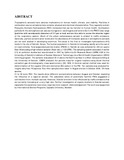Speciation of particulate carbonaceous species at an urban-background site in Nairobi, Kenya.

View/
Date
2010Author
Gatari, Michael
Lavrich, Richard;
Preston, Bill;
Gaita, Samuel
Type
ArticleLanguage
enMetadata
Show full item recordAbstract
Tropospheric aerosols have adverse implications on human health, climate, and visibility. Particles in combustion source emissions have complex physical and chemical characteristics. They regularly contain Polycyclic Aromatic Hydrocarbons (PAH) molecules that can be harmful to human health. Combustion particles in the atmosphere can acts as mutagens or carcinogens and tend to be in the PM2.5 size range (particles with aerodynamic diameters of 2.5 μm or less) and are thus able to access the alveolar region of the respiratory system. Much of the urban carbonaceous aerosol is related to traffic emissions. Generally, particle concentration levels and the abundance of molecular species in atmospheric aerosols are not well studied in developing countries. This study is the first to investigate hydrocarbons (HC) levels in the city of Nairobi, Kenya. The human population in Nairobi is increasing rapidly as is the use of on-road vehicles. Total-suspended particle matter (PM35) in Nairobi air was collected for 24h on quartz fiber filters using a high volume sampler (flow rate = 1130 LPM). The sampling system was used in earlier U.S. air pollution studies but was donated in 1997 by California Air Research Board (CARB) USA to the University of Nairobi's Institute of Nuclear Science & Technology via a World Health Organization (WHO) twinning program. The sampler was placed 20 m above the Earth's surface in a Main Campus building at the University of Nairobi. USEPA analyzed the particle mass for organic markers using direct thermal extraction-gas chromatography mass spectrometry (GC- MS). A thermal optical method was used for determination of the organic (OC) and elemental (EC) carbon in the PM. Ten samples was analyzed for roughly sixty-four HC species. Four filter samples were taken in August and six in October 2006. Of these species,
21 to 26 were PAH. The results show different concentrations between August and October depicting the influence of a regional aerosol. The calculated ratios of potentially harmful PAHs suggested a contribution from multiple sources. However, Nairobi is known to be influenced by traffic emissions that are currently increasing at a very high rate. Further investigation of organic markers in Nairobi aerosol, especially the putatively toxic ones, requires more research. Acknowledgement The work was supported by International Science Programs, Uppsala University, Sweden.
Citation
EGU General Assembly 2010, held 2-7 May, 2010 in Vienna, Austria, p.12567Publisher
University of Nairobi
